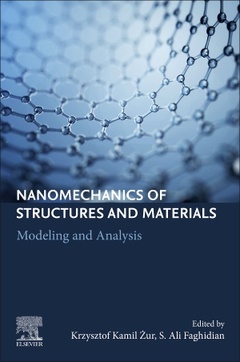Nanomechanics of Structures and Materials Modeling and Analysis
Langue : Anglais
Coordonnateurs : Żur Krzysztof Kamil, Faghidian S Ali

Nanomechanics of Structures and Materials: Modeling and Analysis highlights and compares the advantages and disadvantages of varied modeling and analyzation methods for a broad array of different nanostructures and nanomaterials. It focuses on the behavior of media with nanostructural features where the classic continuum theory does not apply and augmented continuum theories such as nonlocal theory, gradient theory of elasticity, and the surface elasticity model must be used. These theories and models are discussed at length and their application to a variety of different materials and structures, including graphene, shells, arches, nanobeams, carbon nanotubes, porous materials, and more are covered.
1. Mixture unified gradient elasticity versus two-phase local/nonlocal gradient theory
2. Some fundamental electrical and mechanical properties of graphene- and CNT-based nanocomposites
3. Higher order theories for the free vibration analysis of doubly-curved shells made of nanostructured materials
4. Nonlinear Vibration of a Generalised Micro Arch Including Surface Effects
5. Love-type surface wave propagation in a nonlocal elastic layer on a exoelectric solid half-space
6. The inhomogeneous half-plane with surface elasticity effects under dynamic loads: Free field solutions and Green's functions
7. Propagation of Uncertainty in Free Vibration of Nanobeam based on One Variable First-Order Shear Deformation Beam Theory: An Analytical Approach
8. Nonlinear vibration and stability of FG circular micro-plates based on modified couple stress theory
9. Nonlocal discrete and continuous modeling of free vibration of forests of vertically aligned single-/double- walled carbon nanotubes
10. Peridynamic modeling for thermomechanical fracture in porous materials
11. Microstructural effects in nanostructures
12. Displacement-driven approach to nonlocal elasticity
13. ILG Framework & Structural Mechanics
14. Fractional nonlocal elastic rod, beam and plate models applied to lattice structural mechanics
2. Some fundamental electrical and mechanical properties of graphene- and CNT-based nanocomposites
3. Higher order theories for the free vibration analysis of doubly-curved shells made of nanostructured materials
4. Nonlinear Vibration of a Generalised Micro Arch Including Surface Effects
5. Love-type surface wave propagation in a nonlocal elastic layer on a exoelectric solid half-space
6. The inhomogeneous half-plane with surface elasticity effects under dynamic loads: Free field solutions and Green's functions
7. Propagation of Uncertainty in Free Vibration of Nanobeam based on One Variable First-Order Shear Deformation Beam Theory: An Analytical Approach
8. Nonlinear vibration and stability of FG circular micro-plates based on modified couple stress theory
9. Nonlocal discrete and continuous modeling of free vibration of forests of vertically aligned single-/double- walled carbon nanotubes
10. Peridynamic modeling for thermomechanical fracture in porous materials
11. Microstructural effects in nanostructures
12. Displacement-driven approach to nonlocal elasticity
13. ILG Framework & Structural Mechanics
14. Fractional nonlocal elastic rod, beam and plate models applied to lattice structural mechanics
Krzysztof Kamil Zur is a Researcher at the Faculty of Mechanical Engineering, Bialystok University of Technology. He received Ph.D. degree in theoretical and applied mechanics where his research was concerned with applications of meshless methods to the dynamics of discrete-continuous composite structures with a nonlinear distribution of parameters. His current research is related to numerical methods applied to mechanical and aerospace engineering problems and mechanics of materials and structures at different scales.
S. Ali Faghidian received a Ph.D. degree in theoretical and applied mechanics where his Ph.D. research is concerned with the inverse problem of determination of eigenstrains and residual fields. His current research is focused on the rigorous nonlinear structural analysis of nanocomposite materials extensively exploited as essential constituents of new-generation Nano-Electro-Mechanical Systems (NEMS). He served as editor and recognized reviewer in prestigious internationally recognized journals and co-authored a series of recent high-quality contributions published in esteemed international journals with the predominant emphasis on the rigorous elastostatic and elastodynamic analysis of nano-structures in the framework of variationally consistent size-dependent theories of elasticity. He has earned the distinction of being among the top 2% of scientists worldwide in the field of Mechanical Engineering as measured by the impact of the research publications as identified in a worldwide database of top scientists; according to the study perfumed by Stanford University (1788-2022). He is also a member of the International Research Centre on Mathematics & Mechanics of Complex Systems (M&MOCS).
S. Ali Faghidian received a Ph.D. degree in theoretical and applied mechanics where his Ph.D. research is concerned with the inverse problem of determination of eigenstrains and residual fields. His current research is focused on the rigorous nonlinear structural analysis of nanocomposite materials extensively exploited as essential constituents of new-generation Nano-Electro-Mechanical Systems (NEMS). He served as editor and recognized reviewer in prestigious internationally recognized journals and co-authored a series of recent high-quality contributions published in esteemed international journals with the predominant emphasis on the rigorous elastostatic and elastodynamic analysis of nano-structures in the framework of variationally consistent size-dependent theories of elasticity. He has earned the distinction of being among the top 2% of scientists worldwide in the field of Mechanical Engineering as measured by the impact of the research publications as identified in a worldwide database of top scientists; according to the study perfumed by Stanford University (1788-2022). He is also a member of the International Research Centre on Mathematics & Mechanics of Complex Systems (M&MOCS).
- Outlines the advantages and limitations of size-dependent continuum theories and modeling techniques when studying fundamental problems in the nanomechanics of structures and materials
- Discusses various analytical and numerical tools for identifying nanomechanical defects in structures
- Explores a diverse array of structures and materials including graphene, shells, arches, nanobeams, carbon nanotubes, porous materials, and more
Date de parution : 08-2024
Ouvrage de 410 p.
15x22.8 cm
Thèmes de Nanomechanics of Structures and Materials :
© 2024 LAVOISIER S.A.S.



